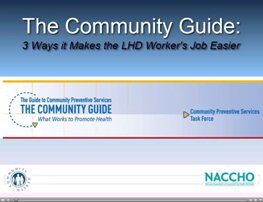
Step 1
CONSULT YOUR CHA/CHIP

Step 2
WRITE A PROBLEM STATEMENT

Step 3
WRITE SMART GOALS AND OBJECTIVES

Step 4
REVIEW AND SELECT STRATEGIES

Step 5
PLAN TO ADAPT AND IMPLEMENT THE STRATEGY

Step 6
IMPLEMENT AND EVALUATE THE STRATEGY
LEARN HOW THE COMMUNITY GUIDE CAN MAKE THE LHD WORKER’S JOB EASIER
View NACCHO’s Screencast Series
THE
COMMUNITY
GUIDE &
THE RESOURCE
CENTER
This site is part of a suite of resources that belong to NACCHO's Resource Center for Evidence-Based Prevention and Cross Sector Approaches.

Click to visit the
Resource Center
Step 5:
Plan to Adapt and Implement the Strategy
Moving forward with evidence-based public health prevention requires sound action planning to move from a broad-based strategy to effective strategic action for implementing the intervention.
Developing a formal action plan is a good way to ensure stakeholders are on the same page about the way a program should be implemented and provides a blueprint for implementing and monitoring your progress. A sound action plan includes a description of your community health priorities, measurable objectives, improvement strategies and performance measures with measurable and time-framed targets; changes needed to accomplish health objectives; roles of project team members and partners, and a plan for monitoring and sustaining success. A logic model can be useful in helping you formulate your action plan, by painting a clear picture of the connections between resources, activities, and outcomes.
Another factor to consider when planning to implement an evidence-based strategy is how you will adapt it to make it relevant for your target audience.
Ensuring impact when implementing evidence-based strategies, means implementing the strategy as it originally was, when it was piloted.
To learn, what can and what cannot be changed when adapting an evidence-based intervention, review the CDC’s Red Light/Yellow Light/Green Light guidelines.
Links to Helpful Tools
- NACCHO’s Community Guide Action Planning Template
- Sample Logic Model Template The CDC’s Red Light/Yellow Light/Green Light guidelines
Learn More
